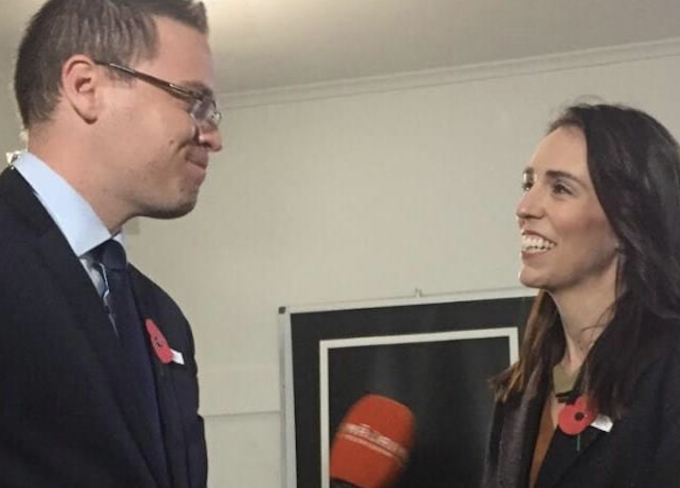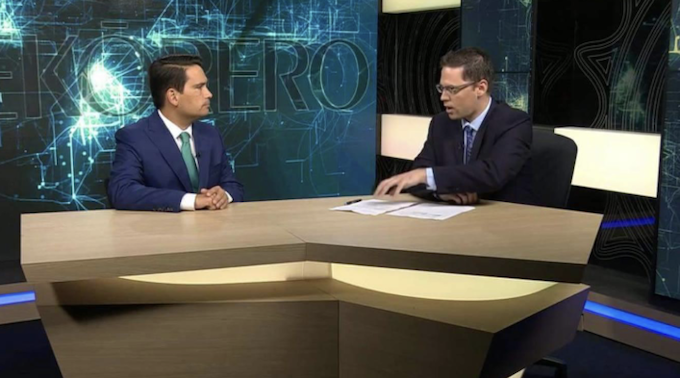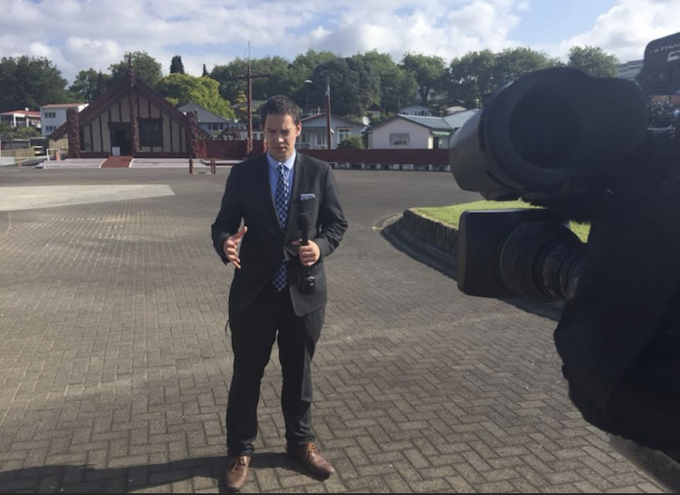
By Hayden Donnell, RNZ Mediawatch producer
WELLINGTON (RNZ Mediawatch/Asia Pacific Report/Pacific Media Centre): You might not know his face, but Māori Television’s Heta Gardiner has been one of the most valuable and memorable contributors to the daily Covid-19 briefings. He explains what it has been like covering a pandemic in a still Pākehā-dominated press gallery.
The near-daily media briefings on Covid-19 often started out combative. Reporters will remonstrate with prime minister Jacinda Ardern and Dr Ashley Bloomfield about contact tracing. They’d barrack on behalf of business owners still unable to trade.
Then about halfway through, something jarring happens. The room will go a little quieter, and a man will ask questions on topics that haven’t been brought up before. Nearly always, they’re about issues affecting Māori.
Te Ao reporter Heta Gardiner’s questions have been a subplot within the daily briefings. They offer a glimpse of a media world with different incentives, priorities and cultural values. When the Alert Level 2 rules were announced on May 7, many reporters honed in on what would happen to bars and restaurants. Gardiner asked whether Māori would be able to practice hongi.
LISTEN: The interview on RNZ Mediawatch
On April 29, Gardiner wanted to know whether worries about widening inequality after the pandemic were justified.
“There is concern within some Māori communities that life after covid will just continue to extend the gap between the rich and the poor. What will you be doing to make sure that does not happen?” he asked.
At other times, Gardiner will bring up smaller-scale community issues overlooked in the sometimes overwhelming rush of daily pandemic news. On April 28, he brought up a rāhui put in place on the Waitahanui river by the Ngāti Tūtemohuta hapū.
Licensed local anglers were angry at being told they couldn’t fish the river. “Who is in the right here?” he asked.
Gardiner’s delivery is part of what makes these questions so startling. His speaking style is clear and considered. He’s not antagonistic. It’s almost soothing to hear him. It can feel like he’s engaging in a separate, less highly charged conference.
Despite that, his questions always glean new information. Because he works for Māori TV, Gardiner doesn’t have the same constraints as his press gallery colleagues. He’s not charged with delivering to mass audiences, and isn’t as bound by the need to deliver succinct soundbites for broadcast.
Most importantly, he’s speaking from a Māori perspective. That’s unusual not just in the press gallery, but in journalism as a whole. Gardiner is one of two Māori journalists who regularly attended the briefings, along with TVNZ’s Maiki Sherman, recently appointed as the Press Gallery’s deputy chair.
Despite moves to increase diversity, most mainstream newsrooms are still deeply wedded to Pākehā ways of thinking and doing business.
Gardiner appreciated the attention his question received because it’s an opportunity to show how journalism could be done a little differently.
For a few minutes around 1.30pm, he had an equal billing with his mainstream colleagues in front of the thousands of people who tuned in to the daily briefings on YouTube or TVNZ. His questions weren’t always the hardest hitting. They didn’t always trip the politicians up.
But they showed the audience what the news would look like through a Māori lens.
Hayden Donnell: Listening to these daily briefings on Covid-19, your voice really stands out. I looked on social media, and it turns out I wasn’t alone in talking about your questions. I’m wondering what sort of feedback you’ve been getting lately?
Heta Gardiner: It has been largely positive, which has been great. I was a political reporter at the last election and being a Māori journalist during the last election, where it was quite the dogfight between Labour and the Māori Party, the feedback wasn’t as nice.
It’s the kind of job where you often get a lot of grief. So it’s nice when it comes to these briefings that I’ve been getting a lot of positive feedback and a lot of messages daily from often strangers, saying “look, I came across your questions and they’re really good, and we appreciate you giving that Māori perspective”.
One of the reasons your questions stand out is that you often draw out issues – as you say, you have a Māori perspective – that haven’t been highlighted as much by the other media present. So on May 7, for instance, you asked whether hongi would be OK to carry out going forward into alert level two. And that’s of course of great concern for Māori but it’s not really something that was as high on the radar for other media. Is that something you experience?
Yeah, absolutely. I’m very aware of the fact that the questions I have and the perspective I have are quite niche when you look at the wider press gallery. The press gallery has now in those stand-ups probably 17, maybe 18 people, and it’s myself that has the Māori perspective.
But it’s always been like that. Every time I’ve gone into that room it’s been one, maybe two [Māori]. It’s just been amplified in this situation because I’m the only one. I’m the only person from Māori media in that room. Which actually gives me quite a lot of freedom and it gives me a space that nobody else has.
How much of that is understandable? Your organisation, Te Ao, has this different focus. You have an entirely Māori remit and these mainstream organisations have a more national remit. How much of them not asking these questions that you’re asking is understandable to you and how much of it is disappointing?
It’s very understandable from the point that I’m aware that they are mainstream and they won’t be focusing on Māori or Pacific issues every day. That’s not my expectation of them nor do I think it should be anyone’s expectation of them. That’s not their job, that’s my job. Their job is mainstream stories.
In saying that though, I would encourage those media, those mainstream media outlets to always have a focus, always have a lens and an eye to the Māori issues. Like you say, I’ve got quite a lot of positive feedback. I’d like to sit here and say that’s because I’m the best and a fantastic journalist, but actually I think a big part of that is because I’m the only one and there is an appetite for Māori issues and Māori questions in that forum. So I would encourage the mainstream journalists, while understanding that they have a mainstream focus, that there is a huge appetite there and there is a lot of potential for Māori-angled stories, Māori issues, Māori questions in those press conferences.

Is that a place where you think more representation could help?
Representation? A hundred percent. Do we need more Māori in that press gallery? A hundred percent. I’m that lone voice. I’ve been that lone voice for that last seven weeks. I’m just that one guy. Do we need more? Absolutely. “Why don’t we have enough?” is the major question.
Is it just that we need mainstream reporters to focus on those Māori questions? Well, actually, I don’t think so. It’s my job to do this. I know it well and I know it intimately. Mainstream journalists will not be able to canvas Māori stories as well as the Māori journalists. I wouldn’t be able to cover a court story as well as a court journalist. So I’m not saying all these mainstream non-Māori journalists need to be getting into this space and tucking in. We need more Māori people in that press gallery and in journalism generally.
Māori people that know how to do Māori stories with Māori focuses, as opposed to encouraging non-Māori to do these stories. We don’t have enough. There’s myself, there’s [TVNZ reporter] Maiki Sherman that are in these conferences. That’s it, of the 40 to 50 journalists that are in the press gallery.
That’s not just the Press Gallery though. They’ve been targeted a lot because they’ve been doing these briefings and they’re the primary journalists on the covid-19 case. But you’re talking to a Pākehā guy in a segment on a show hosted by a Pākehā guy [RNZ’s Mediawatch], and that’s not an uncommon situation. Māori people are underrepresented across the sector, aren’t they?
A hundred percent. You’re right. This has just put a spotlight on the issue. That is the only thing. My colleagues at Māori television and at Te Karere, we have been these tiny voices within a far bigger scope in these press gallery press conferences for years, for 20 years. Before that there was no voice. So this is what’s been happening. The prime minister fronts the media at that [post-cabinet] podium on Monday every week and has done so for 30 or so years. There’s always one token Māori person or max two token Māori people in there, asking those Māori questions, and this has always been the case.
Why? Well, it’s a combination of reasons. But Māori aren’t just needed in the reporter space. Don’t think just because you don’t see enough Māori on a screen, that [if] you put more Māori on those mainstream screens, problem solved. We know in the media that the faces on camera don’t actually call the shots. We front it. We don’t call the shots. The producers call the shots. The bosses call the shots. So that’s a space; we are very much lacking having Māori in that space as well.
Couple of things to draw out: you mention the press gallery getting criticism. Some of the praise for your questions is just “thank god this guy raised this issue”, but some people as well have this way of using your questions as a cudgel to criticise the more mainstream journalists there. Are you comfortable with people doing that?
That’s often the praise I’m getting when people message me, right? They say, “compared to the other questions that I’m hearing, yours are very refreshing”. I will add though that the expectations on a mainstream journalist – you ask very different questions. For example, if you’re asking a question to clip out five minutes out of the prime minister’s press conference or you’re asking a question for a two-minute story for the news. You ask a different question and you ask it in a different way.
I see a lot of flack for my colleagues in the press gallery. I feel a bit sorry for them. I have to say these are real people and New Zealand is so tiny that if you chuck stuff like that on Facebook, there’s a reasonable chance that they’re going to see it. So I feel a bit sorry for my colleagues in that respect. Do I think that every question that’s been asked in those press conferences is right on the money and they’re perfect and they’re awesome? Well, no. In the hundreds and thousands of questions that I’ve asked in press conferences, I’m sure I’ve asked a bunch of duds too. So it’s not perfect and I’m not defending every question but these are people that are working hard.
Your questions often seem to come around the same point in the briefings: about halfway through or toward the end. I just wondered why you often wait so long to put your questions in?
A couple of reasons. One, I’m aware of the fact that there’s a main thread that probably 17 people of the 20 people in the room are going to be chasing. I allow that to lead the press conference and a lot of people have criticised that a lot of the questions are around the same thing. But I let the main thread play its course and then I just jump in after that.
I also like to canvas where the prime minister’s going and the way in which she answers questions. If other journalists ask Māori-pointed questions then I might come off the back of that. So I just sort of survey the canvas, really, and that’s why I’m toward the middle or the end.
Is the press conference setting itself pretty Pākehā in nature? I think of the fact that everyone kind of yells over each other and jockeys for attention. Would that sort of yelling over each other be as acceptable in a purely Māori setting or not?
That’s a great question because that is actually I think one of the reasons why Māori feel quite uncomfortable and intimidated in that environment. It is unnatural. It is still unnatural to me. I’m not as forward and aggressive in those settings. I need to get my questions in and I will press for them but I’m not comfortable yelling over other people. And that’s one of the reasons Māori don’t come into that setting. Because sometimes we have Māori come into that setting and they don’t like asking questions, and they don’t ask questions, because it’s not an environment that’s very comfortable for us.
Would it be run the same way if it was run in a Māori way, in a Māori construct with Māori practices? Absolutely not. But that is one of the reasons why Māori don’t often try to be political reporters. They see the combative nature of how things are run. I mean, that screaming over each other. I don’t think anybody particularly likes it but that’s the nature of the beast and no, Māori don’t feel comfortable with that at all.

That draws out not just a structural issue in journalism but in politics, where politics is run in a very Pākehā way, and these press conferences are an extension of that?
A hundred percent. Like I said, it’s not just that element that Māori feel uncomfortable with. I think there are a variety of reasons why Māori often don’t try for that political space. And that’s something of a challenge for our Māori broadcasters because we need our best people in parliament. Our strongest journalists.
I don’t think that is a difficult task in mainstream journalists. Because I think for the most part mainstream journalists strive to get into that press gallery. That is the pinnacle of journalism. That isn’t as much the case within Māoridom. Yes it’s about how the press gallery is run, well not the press gallery but how politics as a journalist is run, but it’s also the nature of politics. It turns Māori off very quickly.
Lastly, on a personal note, do you feel a little bit lonely as sometimes the only Māori person in the press gallery or asking questions from a Māori perspective in the gallery?
I wish there were a team of us, Hayden. I absolutely wish there were a team of us. Like I said earlier there are some fantastic journalists – Māori journalists – that if they were in there they would be asking excellent questions.
It’s not lonely and it’s not isolated but it is clear to me that I’m basically in a lane all of my own. Would I rather there were a lot of us? Yes. I feel sorry not for myself; I actually feel more sorry for our people at home, and the Māori people at home, that everything’s on me. I ask two, maybe three, questions a day. And that is our perspective. That is our four minutes in front of the prime minister.
How about if we had a team there of Māori journalists who ask Māori-specific questions that I wouldn’t have thought of, and that would be put in front of the prime minister and we’re holding them to account. So the reason I would really want a Māori team there from other news outlets is less so I would feel less lonely, but more for our people at home.
- This article is republished by the Pacific Media Centre under a partnership agreement with RNZ.
- If you have symptoms of the coronavirus, call the NZ Covid-19 Healthline on 0800 358 5453 (+64 9 358 5453 for international SIMs) or call your GP – don’t show up at a medical centre.
- Follow RNZ’s coronavirus newsfeed



